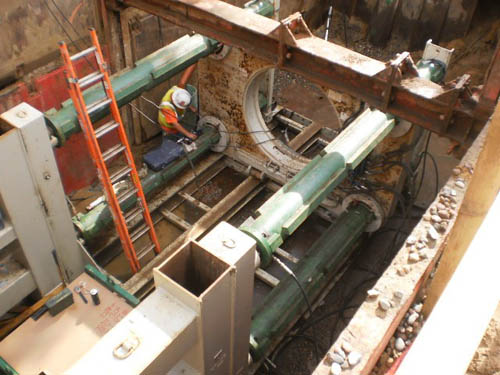Let’s say you have to repair a large concrete sewer pipe that runs under railroad tracks, beneath two large high-pressure gas lines, with high-voltage transmission wires towering overhead—all at the same work site.
REGIONAL INTERCEPTOR SYSTEM
- 640 miles of pipes
- Conveys 250 million gallons of wastewater daily from local sewers to 8 treatment plants
- Average pipe diameter: 36-48 in. Largest diameter: 14 ft.
- Includes pumping stations, access structures, meters to gauge flow from customer cities
- 75% of system built before 1980, 28% before 1960
- Monitored 24/7
That’s just one example of the challenges faced by Metropolitan Council Environmental Services (MCES) as it carries out its systematic, multi-year program to rehabilitate the aging pipes in the massive interceptor sewer network. (See box on right.)
Serving 90% of the region’s seven-county population, the interceptors collect the wastewater from local city sewers and convey it to one of MCES’s eight treatment plants. As part of the rehabilitation program, MCES is repairing or replacing related facilities and structures.
Project spans six communities, three counties
In the region’s northern suburbs, MCES is working on three sections of interceptor in the area where the borders of Anoka, Ramsey, and Hennepin counties come together.
The work sites are located in Mounds View, Fridley, New Brighton, Coon Rapids and small areas of Shoreview and Blaine. At a total cost of about $45 million, the work is part of the larger North Suburban Rehabilitation Project.
The physical challenges of the work can be daunting. The heavy equipment and material used for the work require large staging areas near the construction sites, as well as routes providing access to both. At the same time, MCES works hard to minimize disruption to nearby property owners and transportation corridors, as well as utilities serving the area.
Working under railroad tracks, freeways
 “In Coon Rapids, we were installing a new pipe and had to tunnel under railroad tracks very close to two high-pressure natural gas lines owned by CenterPoint Energy,” said Jeny Shah, MCES senior engineer. “We had to post flaggers on the tracks 24/7 to signal oncoming trains and work very carefully around the gas lines.”
“In Coon Rapids, we were installing a new pipe and had to tunnel under railroad tracks very close to two high-pressure natural gas lines owned by CenterPoint Energy,” said Jeny Shah, MCES senior engineer. “We had to post flaggers on the tracks 24/7 to signal oncoming trains and work very carefully around the gas lines.”
About two miles south at another work site, MCES installed a temporary wastewater diversion system that made it possible to clean and rehabilitate three large pipes buried under Interstate 694.
“We worked cooperatively with private property owners, BNSF rail, the Minnesota Department of Transportation, Hennepin County, and the City of Fridley to set up ten 100-horsepower pumps and route three 30-inch diameter pipes on a railroad bridge over eight lanes of freeway,” said Jeff Schwarz, MCES principal engineer.
Coordination with local governments, utilities is critical
Apart from the physical challenges, MCES has faced the major task of coordinating its work with six cities, three counties, three watershed districts, a railroad company, a utility, plus businesses and individual property owners.
At the time of MCES’s scheduled work, several cities were in the middle of their own construction projects. For example, Mounds View was rehabilitating their local infrastructure, so MCES worked with city staff and contractors to ensure that at least one access route to each neighborhood remained available at all times.
Council maintains frequent communication with the public
Frequent, ongoing communication has been essential to inform and coordinate with all affected parties, said Ron Grajczyk, principal contract administrator. MCES held open houses for the projects where the public could learn about them and ask questions.
For each project, individual webpages are available on the Council’s website, and construction updates are emailed to subscribers. In addition, MCES mailed out information flyers and distributed them door to door.
MCES also held meetings during the design phase and during construction where representatives of affected companies, cities, organizations, as well as individuals could hear in person about the progress of each work project. And a 24/7 phone line was available to provide information, with a commitment to respond within 24 hours.
More information
Sewer Planning and Construction Updates